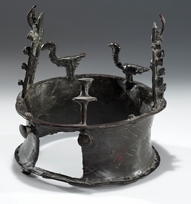World's First Copper Crown On View for the First Time in the US
 Crown with Building-Façade Decoration and Vultures. Copper. H. 17.5 cm; Diam. 16.8 cm. Naḥal Mishmar, 4500–3600 bce.
Crown with Building-Façade Decoration and Vultures. Copper. H. 17.5 cm; Diam. 16.8 cm. Naḥal Mishmar, 4500–3600 bce.Photo: Clara Amit © Israel Antiquities Authority.
A comprehensive selection of artifacts from the Nahal Mishmar Hoard and the Great Burial Cave at Peqi’in, another landmark find, are being seen for the first time in this country from February 12 to June 8, 2014 at The Institute for the Study of the Ancient World at New York University.
The exhibition Masters of Fire: Copper Age Art from Israel presents the fullest array of Copper Age material to ever leave Israel: 157 objects representing the full scope of Copper Age finds made over the last eight decades. A highlight of the exhibition includes a rare blackened copper crown, thought to be the first crown, featuring protruding symbols and painted ossuaries of breathtaking formal inventiveness.
These and other artifacts from Nahal Mishmar and Peqi’in have been joined by bone, stone, and clay figurines, basalt stands with human faces, clay goblets and bowls, and fragments of mats, leather, and textiles found in the Golan Plateau, the Coastal Plain, Beersheba Valley, and the Jordan Valley. Large wall paintings provide context by depicting the period’s rituals.
The collection was discovered while rappelling off a sheer cliff into a remote cave high above the Dead Sea in 1961, an archeologist peered underneath a reed mat and chanced upon the Nahal Mishmar Hoard, which was to prove one of the greatest hoards of antiquity and a game-changing missing piece to the puzzle that is the Chalcolithic Period—or the Copper Age (4,500 to 3,600 BCE).
“To the modern eye, it is stunning to see how these groups of people, already mastering so many new social systems and technologies, still had the ability to create objects of enduring artistic interest,” says Jennifer Y. Chi, ISAW Exhibitions Director and Chief Curator. It was during the Copper Age that people in the Southern Levant discovered not only how to make implements and ritual objects out of copper, but also began to organize hierarchically and glean secondary products like milk and wool from flocks and herds. In the Large Gallery: Nahal Mishmar and Peqi’in An object of enormous power and prestige, the blackened, raggedly cast copper crown from the Nahal Mishmar Hoard greets the visitor to Masters of Fire.
“The fascinating thing about this period is that a burst of innovation defined the technologies of the ancient world for thousands of years,” notes Dr. Master.
Resources:
Also in this Issue:
- Connecting to the Soul of Copper
- Copper Creations Art: A 40-Year Adventure with Solid Copper
- Harnessing Natural Beauty with Copper
- Karisma by Kara
- World's First Copper Crown On View for the First Time in the US
